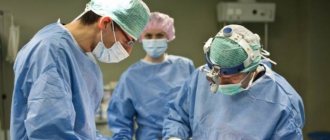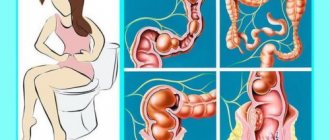Home / Hemorrhoids
Back
Published: 01/28/2020
0
3
- 1 What is the danger of rotavirus infection
- 2 Existing rotavirus vaccines
- 3 Principles and purposes of vaccination
- 4 Is it worth getting vaccinated?
- 5 How to prepare your child
- 6 How is vaccination carried out?
- 7 Post-vaccination reactions
- 8 Vaccine effectiveness
- 9 Contraindications
Up to what age
The optimal age for vaccination is up to 6 months, but sometimes it is carried out after a year. In this case, the child also develops protection against rotavirus infection for several years. After 5 years of age, immunization using Rotatec is considered inappropriate.
By this time, children have already developed immunity to pathogens.
However, if parents want to vaccinate their child, immunization is possible after 5 years.
As a rule, it is performed on children with a weakened immune system and those at increased risk.
Who is at risk?
The most dangerous period for the spread of rotavirus is considered to be from late autumn to early spring. In the Russian Federation alone, more than 85% of morbidity cases were recorded during the winter. The disease is observed both in isolated cases and in the form of epidemic outbreaks. Most often, rotavirus infection affects a person during a seasonal flu epidemic, when the body's protective functions fail.
Basically, rotavirus penetrates into a child’s unformed body before six months or up to one year of life. One third of all cases are children under six months of age.
Most children under five years of age experience a rotavirus infection, which subsequently allows the child’s body to produce antibodies to the infectious viruses. Therefore, the disease at a more mature age manifests itself without acute symptoms and is characterized by a milder form of the course.
Composition of the vaccine
Rotatec contains reassortants of the following types of rotaviruses:
G1;- G2;
- G3;
- G4;
- P1A [8].
The vaccine also contains auxiliary components:
- sodium hydroxide;
- sucrose;
- rotavirus solvent;
- polysorbate-80;
- sodium dihydrogen phosphate monohydrate;
- sodium citrate dihydrate.
Alive or not
Rotatek is a live vaccine. It contains weakened pathogens of rotavirus infection of five strains.
Preparing for vaccination
It is enough to show the child to the doctor on the day of vaccination. The pediatrician assesses his condition, excludes possible contraindications and decides on the possibility of immunization .
After administration of the drug, children should not be restricted in drinking and eating. There is no need to force feed the baby or introduce new foods to the menu.
Expert opinion
Nikolaeva Elena Sergeevna
Practicing pediatrician.
Ask a Question
During the post-vaccination period, it is not prohibited to walk in the fresh air if weather conditions permit. The main thing is to avoid crowded places.
If your child is prone to allergies, you should discuss with your pediatrician the need to take antihistamines. The doctor selects the medication on an individual basis.
Vaccination scheme
The procedure is quite simple and does not cause difficulties:
The ampoule with the solution is opened.- The child opens his mouth.
- The drug is administered behind the cheek.
Immediately after completing these steps, parents and their baby should go home. There are no restrictions on swimming and walking during the post-vaccination period.
The scheme is as follows:
- the product is first instilled at 6-12 weeks;
- up to 32 weeks the full course of vaccinations is completed;
- In total, the drug is administered three times.
How to protect yourself from rotavirus infection
Rotavirus is present in the stool of an infected person, and appears in it several days before the first symptoms and remains up to 10 days after their disappearance. If you wash your hands poorly after going to the toilet, and then touch them to a door handle, telephone, handrail on public transport, toys, dishes, food, the virus will live Pediatric Infectious Disease: Part II, An Issue of Infectious Disease Clinics of North America on these items from a couple of hours to several days.
For further spread, another person needs to touch the same things and then bring unwashed fingers to their mouth (or, say, eat an unwashed apple occupied by rotavirus). In fact, that’s why “stomach flu” is called the disease of unwashed hands; most often the virus is transmitted when hygiene standards are not observed.
There are only two ways to reduce the risk of rotavirus infection.
Wash your hands often
Thoroughly, according to all the rules - always with soap and for at least 15 seconds. If soap and water are not available, use alcohol-based hand sanitizers.
And of course, don’t put unwashed foods in your mouth.
Compatibility with other vaccines
The compatibility with other vaccines of the Rotatec drug deserves special attention. It can be administered simultaneously with almost all drugs included in the vaccination calendar.
Simultaneous use with medications that protect against the following diseases is allowed:
tetanus;- rubella;
- Hib infection;
- diphtheria;
- meningococcal infection;
- hepatitis B virus;
- mumps;
- measles;
- pneumococcal infection.
Rotatek is also compatible with pertussis vaccines, but only those containing acellular virus. It is not used with whole cell preparations.
Simultaneous use with inactivated polio vaccinations is allowed.
Rotatec cannot be combined with oral live polio vaccine. The interaction of these medications has not been fully studied. This combination is thought to reduce the immune response to rotavirus.
Possible reaction to vaccination
There are no consequences observed. Children tolerate the drug well, no negative changes in their condition are noted.
Rarely, the following symptoms may occur:
- temperature increase;
- general malaise;
- nausea;
- diarrhea.
This reaction is considered normal and does not cause concern. After 1-2 days, the baby’s condition returns to normal.
Vaccination schedule
An approximate immunization schedule looks like the following:
at 3, 4 and 6 months;- at 2, 3 and 5 months;
- at 6, 14 and 22 weeks (if early protection is needed).
After 15 weeks, the first dose is not recommended. If there is an urgent need for immunization, only two doses are administered, maintaining an interval of a month.
The duration of the vaccination largely depends on the individual characteristics of the body and varies from two to three years.
Basic methods of treating wisdom teeth
All medications must be prescribed by a doctor. Incorrect treatment can cause great harm. You can use painkillers and anti-inflammatory drugs on your own only for temporary relief. It is not recommended to use them for more than 3-5 days. The following medications help best:
- Analgesics effectively reduce pain: Pentalgin, Solpadeine, Tempalgin and others. And non-steroidal anti-inflammatory drugs also relieve inflammation: Ibuprofen, Nimesil, Nurofen and others. Ketorolac-based drugs are considered the most effective for toothache. They pacify pain for a long time, but often it is not recommended to drink them due to the large number of side effects.
- If it is impossible to take medications orally, use local anesthetics, for example, Lidocaine or Novocaine. It is very convenient to use special preparations for the oral cavity. For example, lubricate the gums with Kamistad, Cholisal or Metrogyl gel, or spray Lidocaine Vial spray. Applying cotton wool moistened with drops of Zelenin to the diseased tooth helps. And if the third molar has already grown and hurts due to caries, you can put a crushed Analgin tablet into the cavity.
- Rinsing with antiseptic solutions helps relieve discomfort. Most often it is recommended to use the following for the oral cavity: “Chlorhexidine”, “Miramistin”, “Elundril” or ordinary potassium permanganate.
- Before removing a wisdom tooth, a comprehensive examination is performed. An x-ray or visiogram is taken (an x-ray examination, the result of which is transmitted to the monitor screen). They also look for diseases that may cause blood to clot poorly or cause wounds to heal slowly (for example, diabetes).
- Wisdom tooth removal begins with pain relief.
- Then the doctor, using medical instruments, moves the gum back, slightly rocks the crown (or rotates it), pries it up and removes the tooth from the gum.
- Sometimes the crown is divided (cut with a drill) into several tips, each of which is removed separately.
- If the crown is destroyed and only the root is removed, then several incisions are made in the gum, and after the operation, sutures are placed.
- After removal, the hole heals within two weeks. Hardening of the gums occurs within 3-4 months.
Operations inside the oral cavity are performed without treating the wound with antiseptics. Human saliva is an antibacterial solution that also disinfects the hole and the cut site.
Removal of a wisdom tooth in the upper jaw requires preliminary radiography to determine the location of the maxillary sinus. If it is close, tooth extraction can lead to perforation (the formation of a hole between the maxillary sinus and the oral cavity). As a rule, such perforation becomes inflamed and requires treatment and suturing.
What side effects may there be?
Despite the fact that Rotatec is most often well tolerated, side effects are sometimes observed during vaccination. Among them:
loss of appetite;- apathy;
- excessive sleepiness;
- rashes on the skin;
- loose stool;
- hyperthermia.
If such symptoms appear, you need to carefully monitor the baby’s condition.
If you notice a deterioration in your health, and side effects become pronounced, you need to seek help from a doctor..
Possible complications
In the post-vaccination period, serious complications may develop. They are observed with contraindications to vaccination.
In this case, the following negative changes may be observed:
severe forms of allergic reaction;- gagging, causing dehydration;
- intussusception;
- volvulus;
- formation of ulcers and erosion;
- internal bleeding.
Wisdom teeth eruption problems
On average, a wisdom tooth is cut between the ages of 16 and 22, but there are exceptions to this rule. In some patients, the “eights” began to appear at the age of forty. This is due to the anatomical features of the jaw structure. With age, the jaw gradually decreases in size, so there is simply no room left for these teeth. Often they are cut incorrectly or not at all. Let us consider in more detail how the eruption of a wisdom tooth differs from other teeth.
The bite of a normal healthy person consists of 32 teeth, we learned this well from school. Basically, by the age of 10, all the teeth have erupted in the mouth, except for the last eighths, which are called wisdom teeth. They usually erupt between the ages of 16 and 22 years. Moreover, if a young person’s body lacks calcium and other microelements, growth slows down.
Provisions
You are very lucky if your wisdom teeth erupted as they should have, without deviation from the vertical. Often, even during the formation period, they occupy an incorrect position in the gum and begin to grow with a deviation from the vertical.
The following positions of wisdom teeth are distinguished: vertical, horizontal, lingual-angular, buccal-angular:
- Vertical is correct, that is, the tooth grows without deviations from the vertical axis.
- The horizontal one is the most difficult, since in this case the tooth cannot erupt, and once it begins to grow, it literally grows into the roots of the neighboring one, destroying it. The “figure eights” located horizontally in the gums must be removed, as they injure the gums, causing inflammation, destroying the adjacent tooth and causing the patient a lot of suffering.
- The lingual-angular position of wisdom teeth, like the buccal-angular position, is most common. In the lingual-angular position, the tooth erupts at an angle toward the tongue, as if inward, and in the buccal-angular position, at an angle outward, toward the cheek.
If the “eights” have partially erupted or have not erupted at all, then the doctor diagnoses wisdom tooth impaction, and the unerupted tooth itself is called impacted. This phenomenon often occurs, since such teeth no longer perform their main function in chewing hard food, a person has somewhat changed his eating habits.
The growth of a wisdom tooth is often accompanied by a number of complications, especially if it is positioned incorrectly in the gum or only partial eruption occurs, that is, the tooth is impacted.
- Since the “eight” takes a long time to erupt, already at the eruption stage, especially if partial eruption occurs, it is affected by caries. This is due to the fact that the eighth teeth are located in a hard-to-reach place in the oral cavity and are difficult to clean from plaque. As a result, the tooth has not yet had time to erupt, but is already almost completely destroyed by caries.
- A partially impacted “figure eight” can provoke the development of pericoronitis - inflammation of the gingival hood that covers it from above. Food debris accumulates underneath it, and pathogenic bacteria actively multiply, which causes an inflammatory process. Over time, serious complications such as periostitis and osteomyelitis may occur.
- A fully impacted wisdom tooth can cause no less problems. It can cause severe facial pain and neuralgia, with pain radiating to the ear, throat, head, and even in the chest and heart area. These must be removed.
- If the "eight" grows horizontally in the jaw, it gradually destroys the roots of neighboring teeth.
- Often, an impacted 8th tooth causes the formation of a cyst, which resolves on its own after the tooth is removed.
- There are known cases when an impacted wisdom tooth “dormant” in the patient’s jaw for many years, and then suddenly “came to life” after dentures were installed on the jaw. As a result of constant injury to the gums, it “woke up” and began to erupt, causing a lot of inconvenience to the patient. Agree - it’s very unpleasant when you suddenly discover that you have a wisdom tooth protruding under your denture. Therefore, dentists recommend removing them.
Unlike other teeth, the rudiments of “eights” are formed not during intrauterine development, but at 3–5 years, when the child’s body is preparing to change the primary dentition to a permanent one. At this age, you can determine the number of future eights (from one to four). However, it is impossible to detect possible developmental pathologies at this stage.
The crown part of third molars is formed at approximately 12 years of age, but the development of the root part takes several more years and can continue even after tooth eruption. Considering that the most common age for the appearance of third molars is 18–25 years, the eruption of wisdom teeth occurs already in adults. However, approximately 10 - 15% have no eights at all, which is why it is considered normal for an adult to have from 28 to 32 teeth.
When the coronal part of a wisdom tooth begins to erupt onto the surface of the soft tissues, this process is rarely asymptomatic. The difficulties are largely due to the fact that wisdom teeth do not have milk analogues, so even if the third molars erupt correctly, a person experiences a number of unpleasant sensations.
- Itching in the eruption area (at the initial stage).
- Inflammation of the gums during the eruption of wisdom teeth.
- Aching or throbbing pain in the jaw.
- Pain when swallowing and difficulty chewing food (especially hard food).
- Temperature increase. The temperature during the eruption of a wisdom tooth in adults increases by an average of 1 - 2 degrees.
- Inflammation of the submandibular lymph nodes.
If there are the beginnings of eights, then there are two options: normal eruption of wisdom teeth or difficult. With the first option everything is very clear. But problems during teething may indicate the presence of pathologies - dystopic and impacted wisdom teeth.
| Type of pathology | Description |
| Dystopia | Incorrect position of the tooth. When a wisdom tooth comes through, it hurts much more than usual. It can push against neighboring teeth, causing them harm. |
| Retention | The tooth is completely or partially hidden in soft tissue or even bone. When a wisdom tooth erupts, the gums hurt and pericoronoritis may develop (inflammation caused by the activity of bacteria that accumulate in the gum hood). |
| Mixed pathology (retention dystopia) | Incorrect position is complicated by tooth retention. The most severe pathology that provokes the occurrence of phlegmon, abscesses and osteomyelitis. |
Symptoms of the eruption of wisdom teeth in adults with suspected development of pathology:
- when a wisdom tooth erupts, the cheek becomes swollen;
- blood and pus are released when a wisdom tooth erupts;
- severe pain in the gums and jaw when wisdom teeth erupt;
- injury to the cheeks and tongue.
Patients' complaints about minor itching at the site of the eruption of a wisdom tooth most often result in the prescription of a drug to reduce sensitivity in the specified area.
In addition, the dentist may suggest that the patient remove a wisdom tooth that causes discomfort. Indications for removal include: 1. The likelihood of damage or destruction of neighboring teeth; 2. Incorrect growth; 3. Inconsistency with the position of the remaining teeth; 4. Caries in an erupting wisdom tooth; 5 .Development of gum inflammation.
Partial eruption of wisdom tooth
Experts recommend that patients have their wisdom teeth removed at the stage of their eruption, because it is unknown how the tooth will behave after the roots have formed.
In addition, it may be difficult to clean the eights due to their distant location, so caries forms on them, which requires separate treatment. Wisdom teeth can come into contact with neighboring teeth, and caries can occur at the site of their contact, and this provokes the development of this process. the entire oral cavity.
Patients with growing wisdom teeth may be concerned about: 1. Pericoronitis. 2. Aching or sharp pain; 3. Difficulty opening the mouth; 4. Swelling of the cheek; 5. Pain when swallowing; 6. Crowding of teeth; 7. Destruction of the teeth in front.
During the eruption of figure eights, their bumps begin to appear on the surface of the gums. The crowns of wisdom teeth remain partially covered with mucous membrane. The area of mucous membrane that covers the growing wisdom tooth is called the “hood.” This formation most often becomes inflamed, because due to the accumulation of food debris in it, microbes gradually accumulate and multiply there, which provoke the occurrence of pericoronitis.
Symptoms of pericoronitis include: 1. Suppuration from under the “hood”; 2. Swelling of the soft tissues around the figure eights; 3. Increased body temperature; 3. Bad breath; 4. Difficulty opening the mouth.
The occurrence of pericoronitis suggests the need for minor surgical intervention; the resulting “hood” is excised. The operation takes a few minutes and can be called low-traumatic.
The position of the wisdom teeth relative to the soft tissue and other teeth may make it impossible to perform surgery to remove the “hood,” so the patient may be advised to remove the wisdom tooth.
Wisdom teeth, due to lack of free space for their growth, can displace the remaining teeth towards the central incisors, so crowding of the dentition may occur.
When examining images, dentists need to estimate the length of the patient’s lower jaw, which should be enough for the growth of figure eights.
Insufficient space for the eruption of wisdom teeth can be called an indication for their removal. Because the development of crowding will require additional treatment to correct the bite, which can take more than a year and the cost of which is an order of magnitude higher than timely tooth extraction.
Contraindications for Rotatek vaccination
Contraindications to immunization include:
- acute poisoning;
- diarrhea;
- disorders of the gastrointestinal tract;
- intestinal obstruction;
- individual intolerance to the components included in the drug;
- elevated temperature;
- colds;
- recovery from a cold;
- tendency to exhibit allergic reactions;
- congenital anomalies of the gastrointestinal tract structure;
- HIV infections;
- immunodeficiency.
Vaccination is carried out with caution in the following cases;
- the presence of gastrointestinal pathologies that occur in a chronic form;
- psychomotor and neurological disorders;
- recent blood transfusion;
- diseases affecting the immune system.




